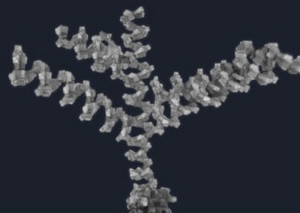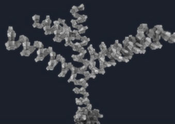Information
- Publication Type: Journal Paper (without talk)
- Workgroup(s)/Project(s):
- Date: October 2014
- ISSN: 1471-2105
- Journal: BMC Bioinformatics 2014
- Number: 345
- Volume: 15
- Pages: 1 – 16
- Keywords: Multi-agent modeling, L-system modeling, Biochemical visualization, Visualization of physiology, Polymerization
Abstract
Background: Research in cell biology is steadily contributing new knowledge about many aspects of physiological processes, both with respect to the involved molecular structures as well as their related function. llustrations of the spatio-temporal development of such processes are not only used in biomedical education, but also can serve scientists as an additional platform for in-silico experiments.Results: In this paper, we contribute a new, three-level modeling approach to illustrate physiological processes from the class of polymerization at different time scales. We integrate physical and empirical modeling, according to which approach best suits the different involved levels of detail, and we additionally enable a form of interactive steering, while the process is illustrated. We demonstrate the suitability of our approach in the context of several polymerization processes and report from a first evaluation with domain experts.
Conclusion: We conclude that our approach provides a new, hybrid modeling approach for illustrating the process of emergence in physiology, embedded in a densely filled environment. Our approach of a complementary fusion of three systems combines the strong points from the different modeling approaches and is capable to bridge different spatial and temporal scales.
Additional Files and Images
Weblinks
BibTeX
@article{Viola_Ivan_IIP,
title = "Interactively illustrating polymerization using three-level
model fusion",
author = "Ivan Koles\'{a}r and Julius Parulek and Ivan Viola and
Stefan Bruckner and Anne-Kristin Stavrum and Helwig Hauser",
year = "2014",
abstract = "Background: Research in cell biology is steadily
contributing new knowledge about many aspects of
physiological processes, both with respect to the involved
molecular structures as well as their related function.
llustrations of the spatio-temporal development of such
processes are not only used in biomedical education, but
also can serve scientists as an additional platform for
in-silico experiments. Results: In this paper, we
contribute a new, three-level modeling approach to
illustrate physiological processes from the class of
polymerization at different time scales. We integrate
physical and empirical modeling, according to which approach
best suits the different involved levels of detail, and we
additionally enable a form of interactive steering, while
the process is illustrated. We demonstrate the suitability
of our approach in the context of several polymerization
processes and report from a first evaluation with domain
experts. Conclusion: We conclude that our approach provides
a new, hybrid modeling approach for illustrating the process
of emergence in physiology, embedded in a densely filled
environment. Our approach of a complementary fusion of three
systems combines the strong points from the different
modeling approaches and is capable to bridge different
spatial and temporal scales.",
month = oct,
issn = "1471-2105",
journal = "BMC Bioinformatics 2014",
number = "345",
volume = "15",
pages = "1--16",
keywords = "Multi-agent modeling, L-system modeling, Biochemical
visualization, Visualization of physiology, Polymerization",
URL = "https://www.cg.tuwien.ac.at/research/publications/2014/Viola_Ivan_IIP/",
}



